Conquest Of The World
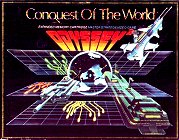 The Game: In probably the weakest of the Master Series games – Odyssey games which included overcomplicated board game elements, a la Quest For The Rings – you control one of the world’s superpowers, attempting to gain as much influence as possible through political and economic means and, where necessary, warfare. (Magnavox, 1980)
The Game: In probably the weakest of the Master Series games – Odyssey games which included overcomplicated board game elements, a la Quest For The Rings – you control one of the world’s superpowers, attempting to gain as much influence as possible through political and economic means and, where necessary, warfare. (Magnavox, 1980)
Memories: Well, that’s what the blurb on the box said. When you ditched the magnetic world map and markers and the colorful chips representing your nation’s influence and power, Conquest Of The World‘s video game component was, essentially, little more than an elaborate Odyssey2 version of the Atari 2600 Combat game, with added terrain and vehicular options and fewer goofy options like bouncing artillery.
Cosmic Conflict!
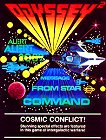 The Game: This is a very simple first-person space game in which you watch various and sundry harmless space freighters waft lazily past your screen, punctuated at regular intervals by TIE-fighter-like attackers which do pose a moderate threat to you (but not much of a moderate threat). (Magnavox, 1980)
The Game: This is a very simple first-person space game in which you watch various and sundry harmless space freighters waft lazily past your screen, punctuated at regular intervals by TIE-fighter-like attackers which do pose a moderate threat to you (but not much of a moderate threat). (Magnavox, 1980)
Memories: It’s a simple game – it’s not inconceivable that one could beat it on the first try.
Circus Atari
 The Game: You control a clown on a moving see-saw, launching your fellow clown into the air to pop balloons and defy gravity. But what goes up must come down, and your airborne clown, if he doesn’t bounce upward upon impact with
The Game: You control a clown on a moving see-saw, launching your fellow clown into the air to pop balloons and defy gravity. But what goes up must come down, and your airborne clown, if he doesn’t bounce upward upon impact with  more balloons, will plummet at alarming speed. You have to catch him with the empty end of the see-saw, thus catapulting the other clown into a fresh round of inflatible destruction. (Atari, 1980)
more balloons, will plummet at alarming speed. You have to catch him with the empty end of the see-saw, thus catapulting the other clown into a fresh round of inflatible destruction. (Atari, 1980)
Memories: It seems like almost every system has seen a version of this game in some form or other, but you may be surprised to learn that Atari wasn’t the first by a long shot. Circus Atari steals its game play and even its setting, lock, stock and barrel, from the obscure black & white Exidy arcade game Circus (1977).
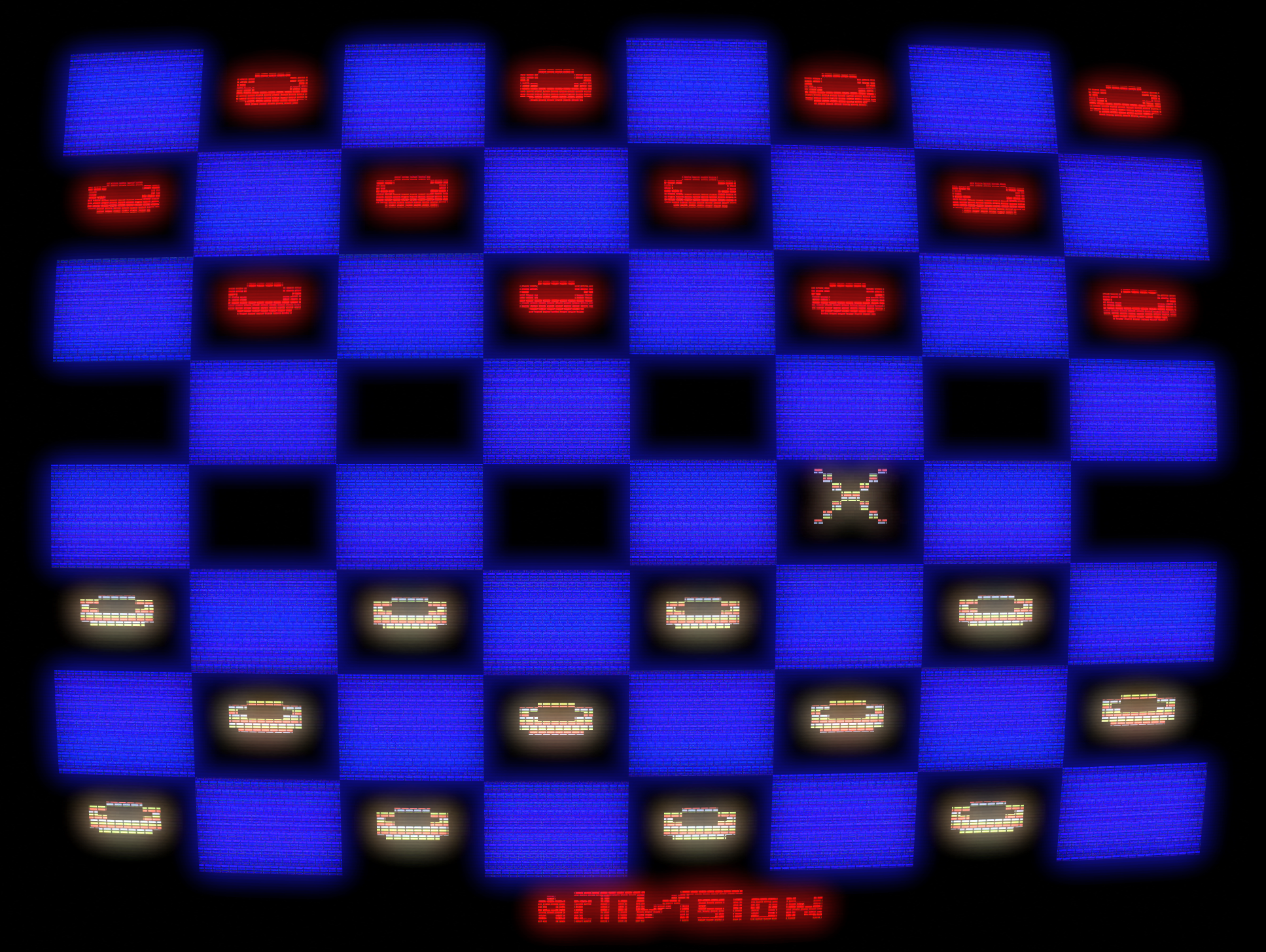
Checkers
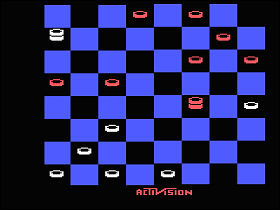 The Game: The classic game of strategy is faithfully reproduced on the Atari VCS. Two armies of twelve men each advance diagonally across the checkerboard, jumping over opponents and attempting to reach the enemy’s home squares to be crowned. Whoever still has pieces still standing at the end of the game wins. (Activision, 1980, for Atari 2600)
The Game: The classic game of strategy is faithfully reproduced on the Atari VCS. Two armies of twelve men each advance diagonally across the checkerboard, jumping over opponents and attempting to reach the enemy’s home squares to be crowned. Whoever still has pieces still standing at the end of the game wins. (Activision, 1980, for Atari 2600)
Memories: Programmed at roughly the same time as Atari’s consumer division was working on Video Checkers, Checkers was one of the first four games released by third-party software upstart Activision – the first company to focus solely on making software for other companies’ hardware.
Checkers

 The Game: The timeless strategy board game of conquest comes to the Intellivision, now with 100% more boopy beepy computerish sounds from the future than any game of Checkers you’ve ever played before! Play alone against the computer, or against a second player. (Mattel Electronics, 1980)
The Game: The timeless strategy board game of conquest comes to the Intellivision, now with 100% more boopy beepy computerish sounds from the future than any game of Checkers you’ve ever played before! Play alone against the computer, or against a second player. (Mattel Electronics, 1980)
Memories: Almost a prerequisite title for any video game console back in this early days, this version of Checkers is curious in that it devotes a lot of screen real estate to showing you the men that have been taken out of play, and shrinks the board itself down to a relatively small space on the screen.
Boxing
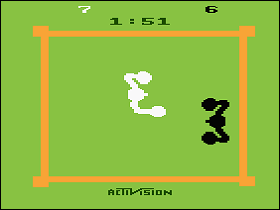
 The Game: The sweet science of bruising is brought down to the pixellated level, as one or two players take control of a boxer seen from a view directly above the ring. The object is simple: knock your opponent out without letting him do the same to you. (Activision, 1980)
The Game: The sweet science of bruising is brought down to the pixellated level, as one or two players take control of a boxer seen from a view directly above the ring. The object is simple: knock your opponent out without letting him do the same to you. (Activision, 1980)
Memories: One of a handful of Activision‘s first releases, Boxing was one of those early sports video games that raised the bar on that entire genre by looking reasonably like the sport it was portraying, rather than something which could be described as an abstract representation at best. It also had the knack of being very easy to pick up and learn – there are no complicated combo moves here.
Blockout! / Breakdown!
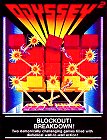 The Game: In this bizarre and uniquely Odyssey2 take on Atari’s Breakout, you battle either the computer or a second player in your attempts to blast through a wall – or repair it. You take alternating turns with your opponent; one round, you’re playing the game the more traditional way and controlling the paddle at the bottom of the screen, trying to bounce the ball toward four layers of colorful blocks. But in the next round, you’re controlling the four androids within those layers of blocks whose duty is to repair damage done by your opponent’s paddle. (Magnavox, 1980)
The Game: In this bizarre and uniquely Odyssey2 take on Atari’s Breakout, you battle either the computer or a second player in your attempts to blast through a wall – or repair it. You take alternating turns with your opponent; one round, you’re playing the game the more traditional way and controlling the paddle at the bottom of the screen, trying to bounce the ball toward four layers of colorful blocks. But in the next round, you’re controlling the four androids within those layers of blocks whose duty is to repair damage done by your opponent’s paddle. (Magnavox, 1980)
Memories: This is one of those examples of a well-worn arcade theme given a new twist by the Odyssey2 game designers. Some of you reading this are probably shaking your heads and thinking, “There they go, ripping off Atari again,” but the repair ‘droids make this a whole new game.
Auto Racing
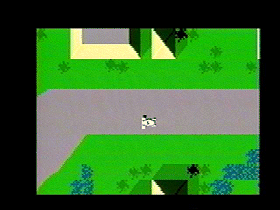
 The Game: Rev up your engines, put the pedal to the metal, and cruise around a track (which apparently has a nice suburban neighborhood in the middle of it, full of folks who no doubt appreciate the roar of engines zipping around them), trying not to go off the asphalt, and trying even harder not to crash into bushes or buildings. (Curiously, water is less of an obstacle.) (Mattel Electronics, 1980)
The Game: Rev up your engines, put the pedal to the metal, and cruise around a track (which apparently has a nice suburban neighborhood in the middle of it, full of folks who no doubt appreciate the roar of engines zipping around them), trying not to go off the asphalt, and trying even harder not to crash into bushes or buildings. (Curiously, water is less of an obstacle.) (Mattel Electronics, 1980)
Memories: In the early marketing blitz for the Intellivision, the image of Auto Racing‘s shaded rooftops and varied terrain was almost inescapable. The previous standard-bearer for this kind of game had been Atari VCS fare such as Indy 500, and on a graphical level at least, this new Intellivision contraption was on a whole different level.
Asteroids

 The Game: As the pilot of a lone space cruiser, you must try to clear the spaceways of a swarm of free-floating asteroids, but the job isn’t easy – Newton’s laws of motion must be obeyed, even by asteroids. When you blow a big rock into little chunks, those chunks go zipping off in opposite directions with the speed and force imparted by the amount of energy you used to dispel them. To that screenful of bite-sized chunks o’ death, add an unpredictable hyperspace escape mechanism and a pesky UFO that likes to pop in and shoot at you, and you’re between several large rocks and a hard place. (Atari, 1980)
The Game: As the pilot of a lone space cruiser, you must try to clear the spaceways of a swarm of free-floating asteroids, but the job isn’t easy – Newton’s laws of motion must be obeyed, even by asteroids. When you blow a big rock into little chunks, those chunks go zipping off in opposite directions with the speed and force imparted by the amount of energy you used to dispel them. To that screenful of bite-sized chunks o’ death, add an unpredictable hyperspace escape mechanism and a pesky UFO that likes to pop in and shoot at you, and you’re between several large rocks and a hard place. (Atari, 1980)
 Memories: This better-than-average translation of Atari’s own arcade smash-hit (in every sense of the term) probably has a lot to do with the game’s enduring popularity.
Memories: This better-than-average translation of Atari’s own arcade smash-hit (in every sense of the term) probably has a lot to do with the game’s enduring popularity.
Alien Invaders – Plus!
 The Game: It’s quite simple, really. You’re the pilot of a ground-based mobile weapons platform, and there are buttloads of alien meanies headed right for you. Your only defense is a trio of shields and a quick trigger finger. If your cannon is destroyed, its pilot must run for cover; each of the three shields contains an extra cannon. When all three shields are gone, the alien commander – a kind of spaceborne crab – will descend to nearly ground level and hunt the helpless pilot down. Ten rounds of this decide the outcome of the war. (Magnavox, 1980)
The Game: It’s quite simple, really. You’re the pilot of a ground-based mobile weapons platform, and there are buttloads of alien meanies headed right for you. Your only defense is a trio of shields and a quick trigger finger. If your cannon is destroyed, its pilot must run for cover; each of the three shields contains an extra cannon. When all three shields are gone, the alien commander – a kind of spaceborne crab – will descend to nearly ground level and hunt the helpless pilot down. Ten rounds of this decide the outcome of the war. (Magnavox, 1980)
Memories: Alien Invaders – Plus! was the first Odyssey 2 game I got hooked on, and my mother just thought it was riotously funny, especially the bit where the giant space squid floats down from the top of the screen to chase your unprotected gunner around when all of your defenses have been depleted.
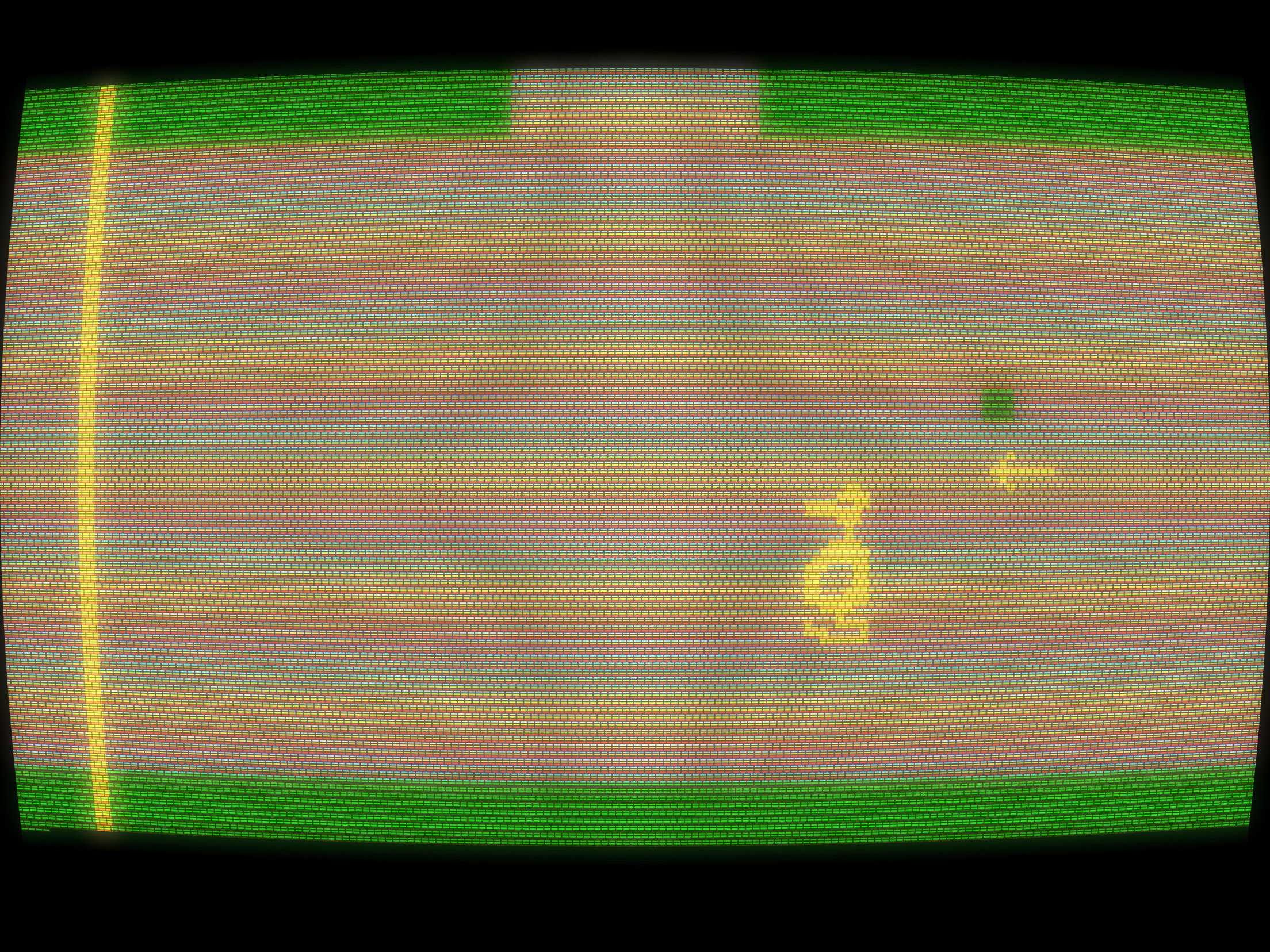
Adventure
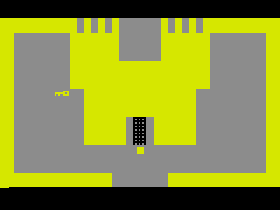
 The Game: As a bold adventurer trespassing a mighty castle in search of treasure, you face a twisty maze of chambers, dead ends aplenty, and colorful, hungry, and suspiciously duck-shaped dragons. (Atari, 1980)
The Game: As a bold adventurer trespassing a mighty castle in search of treasure, you face a twisty maze of chambers, dead ends aplenty, and colorful, hungry, and suspiciously duck-shaped dragons. (Atari, 1980)
Memories: The first game of its kind to hit the Atari VCS, Adventure scores a first in video game history – and not just because of its huge, sprawling maze.
Programmer Warren Robinett was a little disgruntled during his stint at Atari. He watched as his fellow programmers jumped ship, formed companies like Imagic and Activision, and struck it rich as the third-party software industry took off.
“Popeye” Pac-Man
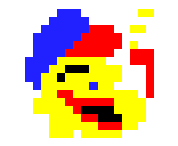 The Game: As a yellow sailor man consisting of a head and nothing else (jaundice was really bad in those days), you maneuver around a relatively simple maze, gobbling small dots and evading four colorful monsters who can eat you on contact. In four corners of the screen, large flashing dots enable you to turn the tables and eat the monsters for a brief period for an escalating score. The monsters, once eaten, return to their home base in ghost form and return to chase you anew. If cleared of dots, the maze refills and the game starts again, but just a little bit faster… (unknown bootleg manufacturer, 1980)
The Game: As a yellow sailor man consisting of a head and nothing else (jaundice was really bad in those days), you maneuver around a relatively simple maze, gobbling small dots and evading four colorful monsters who can eat you on contact. In four corners of the screen, large flashing dots enable you to turn the tables and eat the monsters for a brief period for an escalating score. The monsters, once eaten, return to their home base in ghost form and return to chase you anew. If cleared of dots, the maze refills and the game starts again, but just a little bit faster… (unknown bootleg manufacturer, 1980)
Memories: When Pac-Man took off into the stratosphere, there were two ways that everyone who happened to not be licensed to distribute Pac-Man coped: they made games that played, if not looked, very similar (Lock ‘n’ Chase, Thief, Mouse Trap), or they just flat out copied Pac-Man, making ridiculously insignificant cosmetic changes (Hangly Man, Piranha, and this game). The bootleggers of the latter category, in skipping that pesky development and R&D process involved in creating something original, cashed in by getting their games on the street first.
Wizard Of Wor
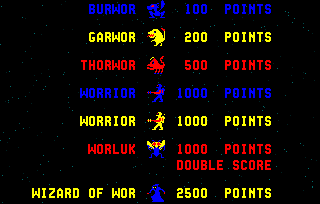 The Game: This should sound pretty famililar to anyone who’s ever played Doom. You (and, if you can find a trigger-happy friend, one other player) suit up as “Worriors” and wander around a twisty maze inhabited by nasty creatures (which can turn invisible and sneak up on you).
The Game: This should sound pretty famililar to anyone who’s ever played Doom. You (and, if you can find a trigger-happy friend, one other player) suit up as “Worriors” and wander around a twisty maze inhabited by nasty creatures (which can turn invisible and sneak up on you).
You must kill them all.
Glad we got these complicated instructions taken care of. (Midway, 1980)
 Memories: This maze game, which hit arcades in 1980, was a true milestone. For one thing, it kept Midway on the map as an arcade game manufacturer (its only previous major successes having been Space Invaders, licensed from Taito, and Galaxian, licensed from Namco) with something other than imported Japanese titles in its repertoire.
Memories: This maze game, which hit arcades in 1980, was a true milestone. For one thing, it kept Midway on the map as an arcade game manufacturer (its only previous major successes having been Space Invaders, licensed from Taito, and Galaxian, licensed from Namco) with something other than imported Japanese titles in its repertoire.
Warlords

 The Game: Think of it as Pong to the death. Two to four players hurl a fireball (multiple fireballs as the game progresses) around the playing field, smashing the walls to each other’s castles and – hopefully – hitting the other players’ kings and putting them out of commission. Your launcher doubles as a mobile barrier around your castle which bounces the fireball right back at your curiously Vader-esque opponents. (Atari, 1980)
The Game: Think of it as Pong to the death. Two to four players hurl a fireball (multiple fireballs as the game progresses) around the playing field, smashing the walls to each other’s castles and – hopefully – hitting the other players’ kings and putting them out of commission. Your launcher doubles as a mobile barrier around your castle which bounces the fireball right back at your curiously Vader-esque opponents. (Atari, 1980)
Memories: Far more famous at home on the Atari VCS than it was in the arcades, Warlords was a really fun game with the right group of friends (or friendly enemies). I’ve only ever seen one machine, and it was a cocktail table (or, to use less industry-specific jargon, a “sit-down”) version – and now that I think about it, it seems like Warlords would have been a bit difficult to pull off as an upright cabinet, but uprights did exist – with B&W monitors only.
Tempest

 As a strangely crablike creature, you scuttle along the rim of an abstract, hollow geometric tube, zapping red bow-tie-ish critters and purple diamond-shaped things which carry them. There are also swirly green things (swirly thing alert!!) which spin “spikes” like webs, and by the way, you should avoid spikes. See below. (Atari, 1980)
As a strangely crablike creature, you scuttle along the rim of an abstract, hollow geometric tube, zapping red bow-tie-ish critters and purple diamond-shaped things which carry them. There are also swirly green things (swirly thing alert!!) which spin “spikes” like webs, and by the way, you should avoid spikes. See below. (Atari, 1980)
Memories: Tempest is a bizarre little game to crack. Since you spend your time rolling around a vaguely tubular structure, the game is controlled with a knob only, and surprisingly, the speed with which you move the control is reflected in your onscreen speed. With some practice, Tempest was a truly addictive, engrossing game, one of the arcade’s best.
Targ
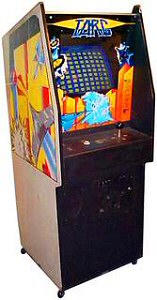 The Game: You’re trapped in a symmetrical maze with a bevy of robotic target vehicles – “Targs” – which are programmed to do just one thing: collide with your vehicle. You have one advantage on these decidedly mean streets, however – you can fire missiles ahead of your car (but the Targs are capable of dodging your projectiles too, so don’t get too cocky). Every once in a while, one of the impregnable blocks in the maze will disgorge a new enemy which is just a little bit faster and deadlier than the rest. Clearing the screen of Targs advances you to a new level with faster enemies – and eventually they’ll put the brakes on your attempts to survive. (Exidy, 1980)
The Game: You’re trapped in a symmetrical maze with a bevy of robotic target vehicles – “Targs” – which are programmed to do just one thing: collide with your vehicle. You have one advantage on these decidedly mean streets, however – you can fire missiles ahead of your car (but the Targs are capable of dodging your projectiles too, so don’t get too cocky). Every once in a while, one of the impregnable blocks in the maze will disgorge a new enemy which is just a little bit faster and deadlier than the rest. Clearing the screen of Targs advances you to a new level with faster enemies – and eventually they’ll put the brakes on your attempts to survive. (Exidy, 1980)
Memories: This is one of those games that’s just emblematic of what was great about the early 80s heyday of the arcade – the graphics did what was required without a lot of embellishment, and the emphasis was on the breakneck speed of the thing. And Targ moved fast. Really fast.
Star Castle
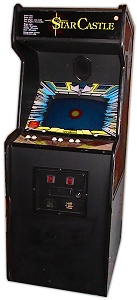 The Game: You control a lone space fighter in the immediate vicinity of the nearly-impenetrable Star Castle. Its three layers of shields rotate, but those layers aren’t solid, so you might be able to get a shot in and destroy the alien craft at its center – but it’s also just as likely that the alien will get a clear shot at you…and its firepower is far greater. (Cinematronics, 1980)
The Game: You control a lone space fighter in the immediate vicinity of the nearly-impenetrable Star Castle. Its three layers of shields rotate, but those layers aren’t solid, so you might be able to get a shot in and destroy the alien craft at its center – but it’s also just as likely that the alien will get a clear shot at you…and its firepower is far greater. (Cinematronics, 1980)
Memories: Tim Skelly’s all-time arcade classic managed to get a cult following despite being eclipsed technologically by some of its contemporaries. In order to get its three rotating shield rings to be multicolored, Star Castle relied on transparent overlays on the monitor – not unlike the TV screen overlays of the original Magnavox Odyssey home video game console – to provide that color.
Space Zap
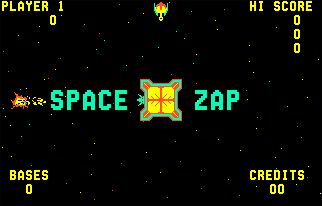 The Game: Players are manning the defenses of a space station under a constant onslaught from all sides by alien attackers. The station’s laser cannons can take out the alien ships and intercept their incoming fire; when an entire wave of attackers is eliminated, a much more mobile fighter will attack, and destroying it will advance the game to the next level of difficulty. (Midway,1980)
The Game: Players are manning the defenses of a space station under a constant onslaught from all sides by alien attackers. The station’s laser cannons can take out the alien ships and intercept their incoming fire; when an entire wave of attackers is eliminated, a much more mobile fighter will attack, and destroying it will advance the game to the next level of difficulty. (Midway,1980)
Memories: Space Zap is a game about helplessness. The player can’t move his space station one inch. It’s only possible to sit, shoot, and maybe sneak in a prayer here and there. Making matters more complicated is the fact that aiming controls and firing controls are separate; if Space Zap simply allowed the player to pick a direction and automatically fire, it’d be almost too easy. As it is, that’s certainly not the case.
Space Panic
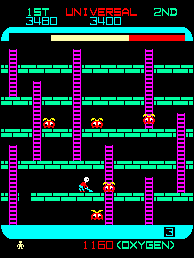 The Game: An astronaut is trapped in an enclosed, vertical space with aliens who have a taste for human flesh. With his oxygen supply running out, he must dig holes in the floors of the multi-level structure and lure the aliens into those holes, which gives him mere seconds to dispose of the trapped aliens by filling the holes in. Clearing a level of aliens replenishes the oxygen tank and deposits the player on a new screen full of aliens, some of whom require extra effort – namely, the carefully-planned digging of an entire vertical shaft to fall through – to kill. (Universal, 1980)
The Game: An astronaut is trapped in an enclosed, vertical space with aliens who have a taste for human flesh. With his oxygen supply running out, he must dig holes in the floors of the multi-level structure and lure the aliens into those holes, which gives him mere seconds to dispose of the trapped aliens by filling the holes in. Clearing a level of aliens replenishes the oxygen tank and deposits the player on a new screen full of aliens, some of whom require extra effort – namely, the carefully-planned digging of an entire vertical shaft to fall through – to kill. (Universal, 1980)
Memories: A fiendishly hard and oft-copied game (particularly in the home computer arena, where it inspired such games as Apple Panic and Lode Runner), Space Panic may well be the first game of its kind: a game in which the player controls someone climbing up and down vertical levels on the screen.
Space Chaser

 The Game: It’s got dots and a maze, but this is no Pac-Man. You’re trapped in a symmetrical maze with an enemy homing missile, and the maze is littered with rows of dots. You must maneuver your ship over these dots to collect them, while avoiding any collision with the missile. If the missile locks on to you from the other end of a long corridor, it will speed up drastically and hit you (unless you can round a corner first). You have no defense against the missile – just avoid it. If you survive long enough to clear the maze of dots, you get to try again – only this time with an additional missile (later screens add even more enemies for you to avoid). You can give your ship a boost by activating your engines, but such speed changes are both short-lived and very costly to your already-dwindling fuel supply. (Taito, 1980)
The Game: It’s got dots and a maze, but this is no Pac-Man. You’re trapped in a symmetrical maze with an enemy homing missile, and the maze is littered with rows of dots. You must maneuver your ship over these dots to collect them, while avoiding any collision with the missile. If the missile locks on to you from the other end of a long corridor, it will speed up drastically and hit you (unless you can round a corner first). You have no defense against the missile – just avoid it. If you survive long enough to clear the maze of dots, you get to try again – only this time with an additional missile (later screens add even more enemies for you to avoid). You can give your ship a boost by activating your engines, but such speed changes are both short-lived and very costly to your already-dwindling fuel supply. (Taito, 1980)
Memories: It seems like around 1980, everyone had a variation on a similar idea. Somewhat resembling Targ and Spectar in the basic tenet of its ships-chasing-each-other-in-a-maze premise, Space Chaser is perhaps the most challenging of its genre for giving the player no option except to flee.
Red Baron
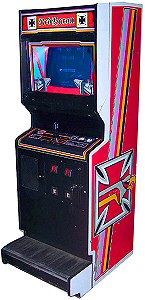 The Game: Take to the sky for some biplane battle with Baron von Richtoven himself! In a combat environment where banking too sharp can either be a daring maneuver or certain doom, your mission is to take out as many enemies as you can
The Game: Take to the sky for some biplane battle with Baron von Richtoven himself! In a combat environment where banking too sharp can either be a daring maneuver or certain doom, your mission is to take out as many enemies as you can  before you yourself accumulate too many bullet holes in the sides of your biplane. Dirigibles also make tempting targets and, for the truly daring, there are land-based tanks nestled near mountains and civilian homes. The game is over when the last of your planes is shot down. (Atari, 1980)
before you yourself accumulate too many bullet holes in the sides of your biplane. Dirigibles also make tempting targets and, for the truly daring, there are land-based tanks nestled near mountains and civilian homes. The game is over when the last of your planes is shot down. (Atari, 1980)
Memories: Emboldened by their first-person tank combat simulator Battlezone, Atari also set out to create the first ever first-person flight combat simulator. (Presumably this fascination with first-person combat sims predated Atari’s shotgun wedding with the U.S. Army that resulted in the Bradley Infantry Fighting Vehicle Trainer.) And lest you think there’s no connection between Battlezone and Red Baron, take a close look at that cabinet – it’s exactly the same design as the Battlezone cabinet, minus the periscope-style viewer and second joystick.
Radar Scope
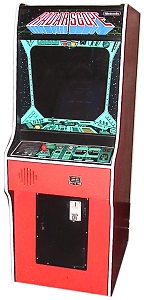 The Game: Why is it that, when aliens invade the Earth, you’re the only person on call? Doesn’t the front office have a more recent phone list? At any rate, wave after wave of aliens attack, dive-bombing you repeatedly and – providing you don’t blast them out of the sky – rejoining their formations to attack anew. These aliens are a particularly nasty breed, as they can fire while diving and retreating. If you can clear the screen of extraterrestrial nasties, the invasion begins again. Are you getting overtime for all this alien-blasting? What are the benefits like? (Nintendo, 1980)
The Game: Why is it that, when aliens invade the Earth, you’re the only person on call? Doesn’t the front office have a more recent phone list? At any rate, wave after wave of aliens attack, dive-bombing you repeatedly and – providing you don’t blast them out of the sky – rejoining their formations to attack anew. These aliens are a particularly nasty breed, as they can fire while diving and retreating. If you can clear the screen of extraterrestrial nasties, the invasion begins again. Are you getting overtime for all this alien-blasting? What are the benefits like? (Nintendo, 1980)
Memories: A pretty obscure entry from Nintendo, this 1980 rip-off of Galaxian adds some cool touches, such as the odd perspective which barely hints at 3-D, and the turning, tumbling alien ships. When one considers that Zaxxon was at least two years away with its primitive (but at the time impressive) isometric graphics, Radar Scope‘s obscurity is not well-deserved.
Rally-X
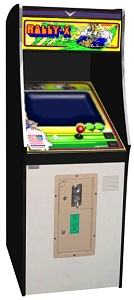 The Game: Go, Speed Racer, go! (Well, almost.) As the driver of a high-powered race car, you rocket around corners and down straightaways, trying to pick up every yellow flag in the maze-like course and avoiding deadly collisions with pursuing red cars. Watch out for rocks and oil spills, and use your smokescreen
The Game: Go, Speed Racer, go! (Well, almost.) As the driver of a high-powered race car, you rocket around corners and down straightaways, trying to pick up every yellow flag in the maze-like course and avoiding deadly collisions with pursuing red cars. Watch out for rocks and oil spills, and use your smokescreen  only when necessary to distance yourself from the red cars. (Bally/Midway [under license from Namco], 1980)
only when necessary to distance yourself from the red cars. (Bally/Midway [under license from Namco], 1980)
Memories: Namco released Rally-X at the same time as Pac-Man, and like Pac-Man, Namco licensed Rally-X to Midway. In fact, the major buzz at that year’s AMOA (Amusement Machine Operators’ Association) annual trade show – where arcade owners tried to figure out which would be the hottest new games to buy for their establishments – was for this dandy little racing/maze game, and Pac-Man was considered an also-ran, perhaps a little too abstract for the U.S. market.
Phoenix
 The Game: In a heavily armed space fighter, your job is pretty simple – ward off wave after wave of bird-like advance fighters and Phoenix creatures until you get to the mothership, and then try to blow that to smithereens. All of which would be simple if not for the aliens’ unpredictable kamikaze dive-bombing patterns. The
The Game: In a heavily armed space fighter, your job is pretty simple – ward off wave after wave of bird-like advance fighters and Phoenix creatures until you get to the mothership, and then try to blow that to smithereens. All of which would be simple if not for the aliens’ unpredictable kamikaze dive-bombing patterns. The  Phoenix creatures themselves are notoriously difficult to kill, requiring a direct hit in the center to destroy them – otherwise they’ll grow back whatever wings you managed to pick off of them and come back even stronger. (Taito, 1980)
Phoenix creatures themselves are notoriously difficult to kill, requiring a direct hit in the center to destroy them – otherwise they’ll grow back whatever wings you managed to pick off of them and come back even stronger. (Taito, 1980)
Memories: Phoenix is one of my two favorite games to emerge from the shooting game genre which emerged from the success of Taito’s own Space Invaders. Most shooter games involve chance, luck, and precious little skill, and very few of them give you the chance to try to work out any kind of strategy. Two exceptions I can think of are Midway’s Galaga and this game.
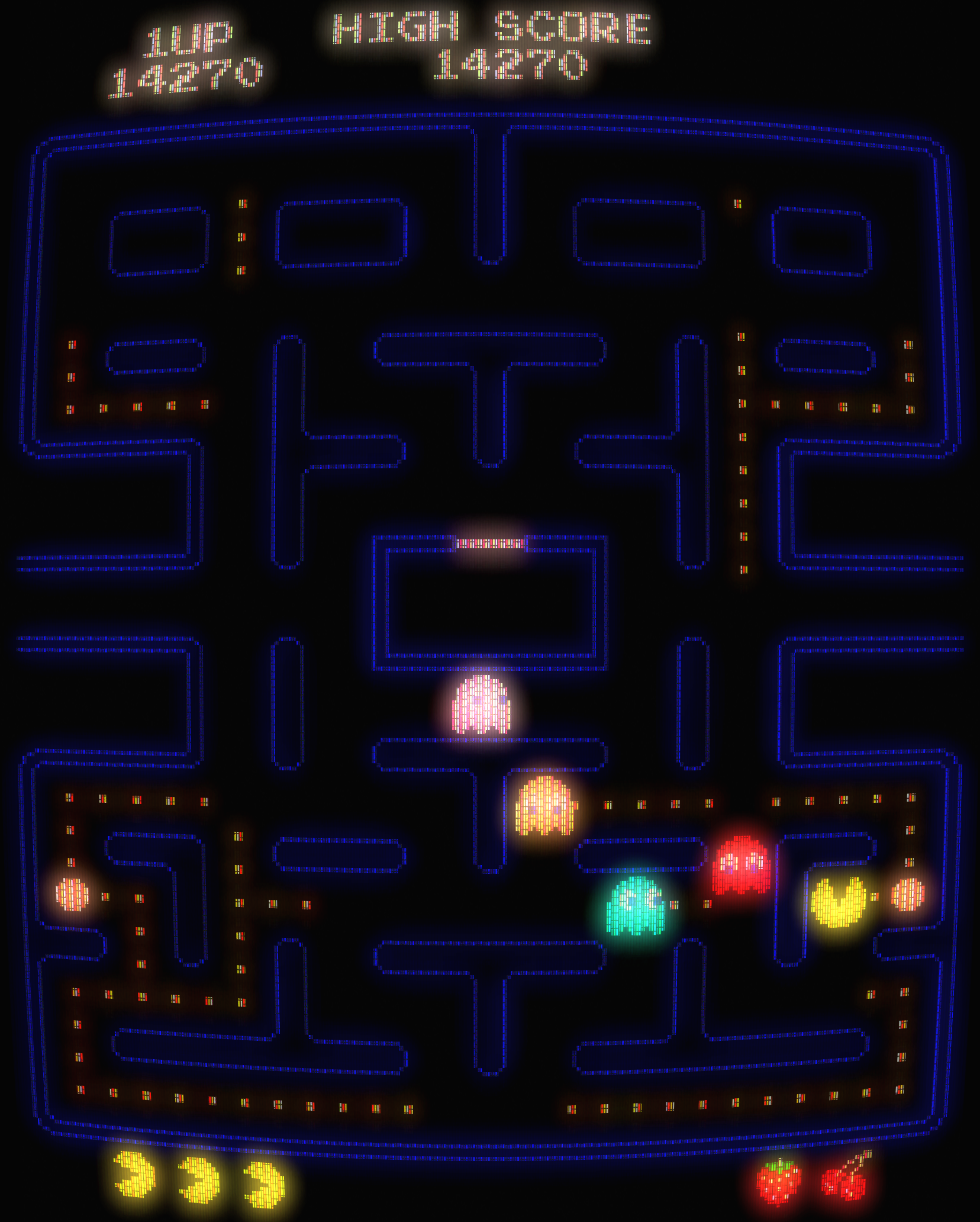
Pac-Man
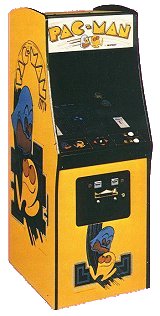
 The Game: As a round yellow creature consisting of a mouth and nothing else, you maneuver around a relatively simple maze, gobbling small dots (10 points) and evading four colorful monsters who can eat you on contact. In four corners of the screen, large flashing dots (50 points) enable you to turn the tables and eat the monsters for a brief period for an escalating score (200, 400, 800 and 1600 points). Periodically, assorted items appear near the center of the maze, and you can consume these for additional points as well. The monsters, once eaten, return to their home base in ghost form and return to chase you anew. If cleared of dots, the maze refills and the game starts again, but just a little bit faster… (Bally/Midway [under license from Namco], 1981)
The Game: As a round yellow creature consisting of a mouth and nothing else, you maneuver around a relatively simple maze, gobbling small dots (10 points) and evading four colorful monsters who can eat you on contact. In four corners of the screen, large flashing dots (50 points) enable you to turn the tables and eat the monsters for a brief period for an escalating score (200, 400, 800 and 1600 points). Periodically, assorted items appear near the center of the maze, and you can consume these for additional points as well. The monsters, once eaten, return to their home base in ghost form and return to chase you anew. If cleared of dots, the maze refills and the game starts again, but just a little bit faster… (Bally/Midway [under license from Namco], 1981)
Memories: It began in 1979 when a young Namco game designer named Toru Iwitani made his fourth video game. Fascinated with pinball, Iwitani had created a series of games combining pinball physics with Breakout-style brick-busting elements, and while Gee Bee, Bomb Bee and Cutie Q were moderate successes for Namco, enough to keep Iwitani employed and developing new titles, the designer himself was finally ready to move beyond video pinball. Cutie Q was one of the first hints as to Toru Iwitani’s next project, with its colorfully cartoony monsters. With a small team of developers at his disposal, Iwitani – supposedly inspired by the shape of a pizza with one slice removed – set about creating a new game with nearly universal appeal.
Moon Cresta
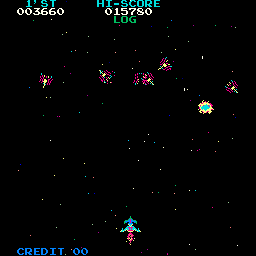
 The Game: As commander of the three-stage fighter rocket Moon Cresta, your job is to ward off endless varieties of evasively weaving space attackers. Every time you knock out two consecutive screens of assailants, you’ll have an opportunity to dock your ship to another one of Moon Cresta’s three stages, until all three portions of the ship are combined to create one bad-ass weapons platform. But you can also lose stages very quickly, ending your game – a bigger ship makes a bigger and easier target. (Sega/Gremlin [under license from Nichibutsu], 1980)
The Game: As commander of the three-stage fighter rocket Moon Cresta, your job is to ward off endless varieties of evasively weaving space attackers. Every time you knock out two consecutive screens of assailants, you’ll have an opportunity to dock your ship to another one of Moon Cresta’s three stages, until all three portions of the ship are combined to create one bad-ass weapons platform. But you can also lose stages very quickly, ending your game – a bigger ship makes a bigger and easier target. (Sega/Gremlin [under license from Nichibutsu], 1980)
Memories: Moon Cresta had a very cool idea which was ripped off by a handful of its contemporaries – instead of giving the player a set number of “lives,” players had three rocket stages. Losing even one stage could seriously hamper your life expectancy in the game in later levels, and you could lose a stage to anything from enemy fire to not lining your stages up correctly during docking. This actually made Moon Cresta a very challenging game – but also a very fun one.
Missile Command
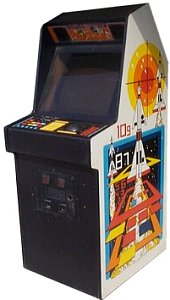
 The Game: Tucked away safely in an underground bunker, you are solely responsible for defending six cities from a relentless, ever-escalating ICBM attack. Your three missile bases are armed with nuclear missiles capable of intercepting the incoming enemy nukes, planes and smart bombs. One nuke hit on any of your three launch bases will incapacitate that facility for the rest of your current turn, but one nuke hit on any of your six cities will destroy it completely. (The only chance you have of rebuilding a city comes when a bonus city is awarded for every 10,000 points scored.) And when all six of your cities have been destroyed, the cataclysmic end of the world proceeds. Game over. (Atari, 1980)
The Game: Tucked away safely in an underground bunker, you are solely responsible for defending six cities from a relentless, ever-escalating ICBM attack. Your three missile bases are armed with nuclear missiles capable of intercepting the incoming enemy nukes, planes and smart bombs. One nuke hit on any of your three launch bases will incapacitate that facility for the rest of your current turn, but one nuke hit on any of your six cities will destroy it completely. (The only chance you have of rebuilding a city comes when a bonus city is awarded for every 10,000 points scored.) And when all six of your cities have been destroyed, the cataclysmic end of the world proceeds. Game over. (Atari, 1980)
Memories: Possibly the first video game ever to register on the so-called moral compass, Atari’s Missile Command contained a strong, anti-nuclear message, arriving at the dawn of Ronald Reagan’s presidency. For those of you who weren’t alive at that time, here’s a little bit of historical context.
Magical Spot
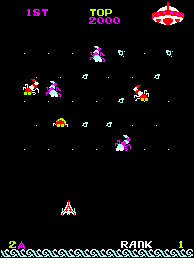 The Game: The good news: Darwin was right, evolution is a thing. The bad news: this does not work in your favor. You man a laser cannon trying to intercept alien insects making their way toward the bottom of the screen; at the most inconvenient times, the bugs revert to a pupal stage during which they’re either impossible to hit or invulnerable. They then emerge in a newer, faster, deadlier form bent on destroying you. (Universal, 1980)
The Game: The good news: Darwin was right, evolution is a thing. The bad news: this does not work in your favor. You man a laser cannon trying to intercept alien insects making their way toward the bottom of the screen; at the most inconvenient times, the bugs revert to a pupal stage during which they’re either impossible to hit or invulnerable. They then emerge in a newer, faster, deadlier form bent on destroying you. (Universal, 1980)
Memories: Evolution is a pretty interesting idea to try to frame in the context of a game; almost without exception, it’s been used as an excuse for the game to suddenly make either the player’s enemies stronger and faster. The strangely titled Magical Spot – referring, perhaps, to the single-pixel points on the screen upon which enemy bugs can perch and shrink down to un-shootable size – is a prime example.
King & Balloon
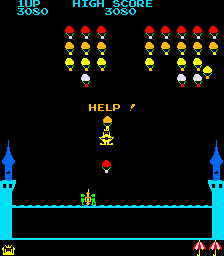
 The Game: Manning a fairly agile cannon located on a platform at a castle, your task is simple: protect the King! However, there’s a flotilla of even more agile balloons above you who are there to kidnap his royal highness. As the King is hoisted away by his assailants, he yells “Help!” If you shoot down the offending balloon, the King shouts “Thank you!” as he floats back to the safety of the castle via an umbrella. The balloons can ram your cannon kamikaze-style and flatten it for a few seconds, but curiously, you have an unlimited supply of cannons. However, if the balloon marauders get three Kings off the screen, your game ends. (Namco, 1980)
The Game: Manning a fairly agile cannon located on a platform at a castle, your task is simple: protect the King! However, there’s a flotilla of even more agile balloons above you who are there to kidnap his royal highness. As the King is hoisted away by his assailants, he yells “Help!” If you shoot down the offending balloon, the King shouts “Thank you!” as he floats back to the safety of the castle via an umbrella. The balloons can ram your cannon kamikaze-style and flatten it for a few seconds, but curiously, you have an unlimited supply of cannons. However, if the balloon marauders get three Kings off the screen, your game ends. (Namco, 1980)
Memories: One of the most bizarre and obscure entries in the resumè of Namco (also responsible for classics like Galaga, Xevious, Dig Dug and a little thing we call Pac-Man), King & Balloon comes across as nothing so much as a bizarre attempt to repurpose Galaxian into a cutesy game. The one-shot-on-screen-at-a-time, the attack patterns of the balloons and some of the sound effects hammer the similarities home.
Defender
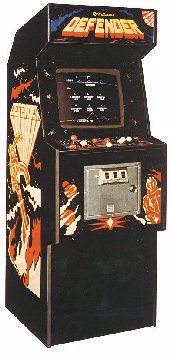
 The Game: Alien invaders besiege the helpless population of a planet, and you are the last line of defense. Ideally, you must destroy the aliens before they can abduct humanoids from the ground; if an alien ship gets to the top of the screen with a captive, it absorbs that unlucky soul and it becomes a much more dangerous and aggressive Mutant. Smart bombs give you the option to wipe out everything alien on the screen, but of course you only have three of them at the outset of the game. You can also perform an emergency hyperspace warp, but you could rematerialize in a far more perilous situation than the one you just left. When you go to the next level by eliminating an entire alien fleet, you receive a bonus multiplied by the number of humans who are still safely on the ground. (Williams Electronics, 1980)
The Game: Alien invaders besiege the helpless population of a planet, and you are the last line of defense. Ideally, you must destroy the aliens before they can abduct humanoids from the ground; if an alien ship gets to the top of the screen with a captive, it absorbs that unlucky soul and it becomes a much more dangerous and aggressive Mutant. Smart bombs give you the option to wipe out everything alien on the screen, but of course you only have three of them at the outset of the game. You can also perform an emergency hyperspace warp, but you could rematerialize in a far more perilous situation than the one you just left. When you go to the next level by eliminating an entire alien fleet, you receive a bonus multiplied by the number of humans who are still safely on the ground. (Williams Electronics, 1980)
Memories: For many people, Defender is the pinnacle of video games, hands down. Fast-moving, unrelenting, hard to beat but easy to become addicted, Defender was always a bit too fast for me – but it’s a perennial favorite for so many others.